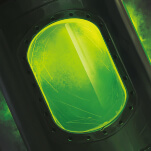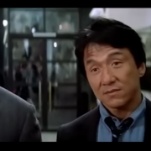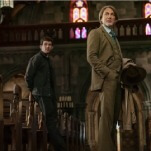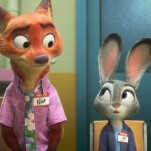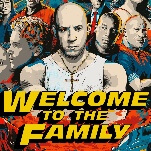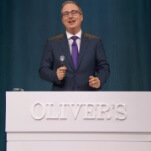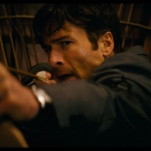Let’s get the elephant in the room out of the way first: The Making Of A Lady is definitely racist. Admittedly, it is an adaptation of two novels written in 1901, so its source material is racist, too. But those novels aren’t exactly widely known, and on first watch, the made-for-TV adaptation is a bizarrely disjointed costume drama that starts out as a slow-burning love affair and ends up vilifying Hindus as practitioners of black magic.
The film tells the story of Emily Fox-Seton, a young, educated woman who has no money and few prospects. She’s smart and kind, but that does not seem destined to take her out of her rented flat in London, where she is three weeks behind on rent. Then a middle-aged marquis sweeps (politely walks) into her life and offers her a marriage of convenience—he needs a wife to satisfy his family, and she needs security. The lady-making happens very quickly—one day, Emily is a mild-mannered personal assistant, and the next day, she is a member of the landed gentry.
A mere 40 minutes later, an elderly Indian woman in a sari attempts to abort Emily’s pregnancy with several glasses of cinnamon milk.
To give credit where credit is due, the first half of The Making Of A Lady actually shapes up to be a very nice, if subtle, film. Lydia Wilson as Emily makes for a nuanced heroine, whose expressive eyes make up for the lack of intelligent lines she’s given. And the production includes the requisite sweeping shots of the English countryside and fantastic costuming, which help to break up the sentimental monotony. Emily and her husband learn to love each other (and to have chaste Victorian sex), and the house begins to feel a little more like a home.
But the second half, which bubbles up out of nowhere, jerks the sweet love story towards gothic melodrama. The story is suddenly weighed down by what is intended to be creeping Oriental horror: Emily’s husband is sent to India to put down an uprising, and while he’s gone, his charismatic cousin Osbourn (James D’Arcy) and Osbourn’s Indian wife show up and try to wrest the estate from Emily’s hands.
In and of itself, that’s nothing new: bad guys will be bad guys. But the flavor of the suspense gradually takes on a quality that treats India and everything from it like a toxic infection. Osbourn can’t be trusted because he spent time in India, found an Indian wife, and contacted malaria, which makes him suffer fits of insanity. And after Emily gets pregnant, the Osbourns turn their attention to aborting that pregnancy—which feels like nothing less than a heavy-handed allegory for cultural purity.
But Osbourn’s wife isn’t the only Indian in the house. Partway into her stay, she sends for her ayah, and a broader caricature of “magical exotic woman” could not be possible. Ameerah is a pastiche of “witch” stereotypes—elderly, dressed in exotic clothes, muttering in strange languages, and endowed with arcane knowledge. As Osbourn frightens away servants with his fits of madness, Ameerah gradually takes over the house—serving Indian food at supper, providing Emily tonics for her pregnancy that make her more and more ill, and spying on Lady Walderhurst whenever convenient. It culminates in the pillow-suffocating moment, which is all the more hilarious because surely a strong English young woman could knock over an old lady, even while pregnant? But the melodramatic terror of the Other here is too strong for logic to penetrate.
On one hand, ITV’s dedication its flawed source material is admirable—no one watching the first 10 minutes of the film, which consist mostly of Emily taking notes for a rich lady, would guess that the story would end with a trio of either magical or malaria-crazed interlopers trying to force her to abort her child. The Making Of A Lady is based on The Making Of A Marchioness and its sequel, The Methods Of Lady Walderhurst, both the works of Frances Hodgson Burnett, celebrated author of A Little Princess and The Secret Garden.
There are some allowances to be made here for the flawed perceptions of the era. It is not The Making Of A Lady’s fault that it is built on two very different books that are ostensibly about the same character. But it is the film’s fault for not attempting to knit together these stories better—and ITV’s fault in choosing to adapt the novels so faithfully. Everything else aside, it’s perplexing that any television producer would read these two novels and think, “Yes! Perfect for modern television!”
It would have been fantastic, too, if this film had engaged with the crazy subtext lurking underneath the surface in The Making Of A Lady—similar to the re-readings of The Turn Of The Screw, for example. Instead, the film plays it annoyingly straight. There’s no measure of self-awareness or camp in Emily’s screams as Ameerah tries to suffocate her with a pillow; no modern lens of awareness that turns onto a problematic text and examines it.
If it were current, The Making Of A Lady would fall into that A/F range that Ryan Murphy’s American Horror Story is always flirting with: The archetypes in use are powerful, but the thematic outcome is rarely better than muddled. But The Making Of A Lady is an artifact of the (very flawed) past. It’s intriguing to see England’s colonial power addressed in one of these costume dramas, but at the same time, there is no effort spared to make it clear that the true malady here is the toxicity of the foreign—whether that’s with the ayah’s brooding stares, Osbourn’s illness, or Lord Walderhurst’s absence.
Some stories are better left in the past.
Written by: Kate Brooke, Frances Hodgson Burnett
Debuts: Sunday at 10 p.m. Eastern on PBS
Format: Made-for-TV movie



